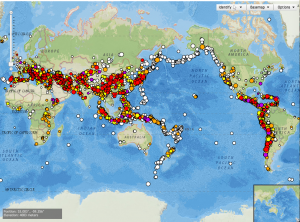The National Oceanic and Atmospheric Administration (NOAA) has an interactive map called the Natural Hazards Viewer. This map contains data on both recent and historic significant natural disasters. The dataset includes tsunami events, tsunami observations, significant earthquakes, significant volcanic eruptions, volcanoes, Deep-Ocean Assessment and Reporting of Tsunamis (DART) Deployments, plate boundaries, tsunami times, and selected significant tsunami events. When browsing the user can select which type of hazard they would like to see information on, and then the user can select different data points detailing these events. There is a wide range of information available between points, some simply contain the date, location, and type of event, while others contain information on the fatalities, social and economic impacts, and information on the individual witnesses, and the events leading up to the natural disaster.
NOAA’s Natural Hazards Viewer compiles a large quantity of information natural disasters onto an easy to navigate and interactive interface. They get their data from the National Geophysical Data Center, which records data on earthquakes, tsunamis, and volcanic eruptions, in order to support research, planning, and mitigation efforts. I thought this was a really interesting use of GIS in order to create a map that not only compiles all the spatial data, but contains all the social and economic data as well. I would definitely recommend everyone play around with this website at some point, it is a really fascinating, freely available resource!
https://maps.ngdc.noaa.gov/viewers/hazards/

